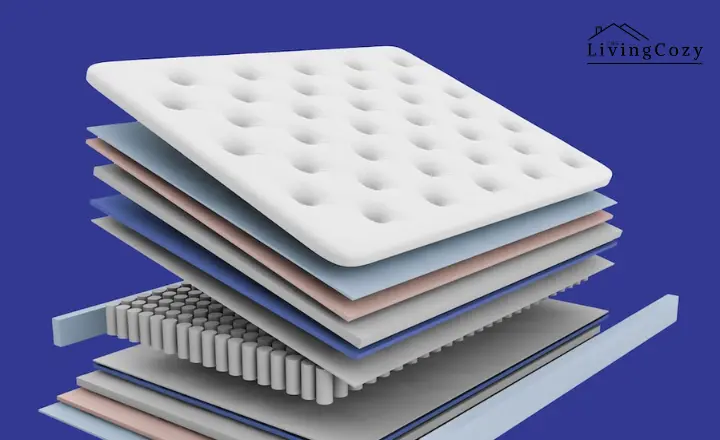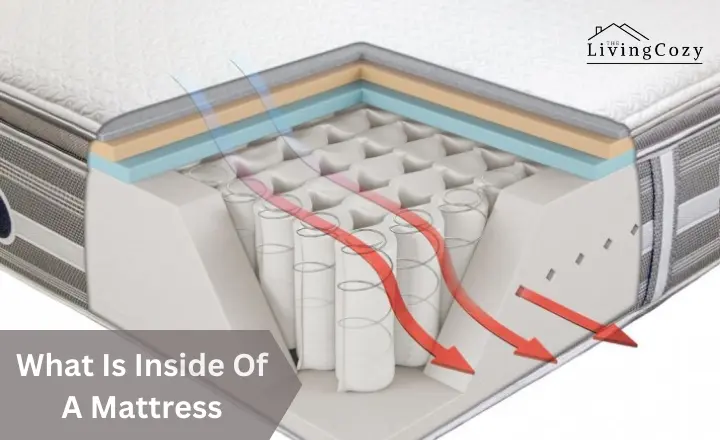Inside every mattress is a carefully constructed blend of materials designed to provide support, comfort, and durability. From resilient coils to plush foam layers, the inner workings of a mattress are more complex than meets the eye.
We’ll deeply dive into What is inside Of a mattress and explore the fascinating components contributing to a good night’s sleep. So buckle up and get ready to uncover the mysteries hiding beneath your cozy bed.
Cover or Ticking:
The inside of a mattress cover, or ticking, is typically made of a durable and tightly woven material such as Belgium Damask. This material is chosen to resist wear and tear, ensuring the mattress’s longevity.
Some mattresses may offer a choice of fabrics for the cover, allowing for customization based on personal preferences.
To the outer material, most mattresses come with a quilted or tufted sleeping surface. Quilted mattresses have a smoother and flatter surface, while tufted mattresses have a contoured surface for added comfort.
These design elements contribute to the overall feel and support provided by the mattress, enhancing the sleeping experience for the user.
Vents:
You will typically find small holes or perforations designed to allow air to flow in and out of the mattress. These vents help to regulate the temperature and humidity inside mattress, preventing moisture buildup and promoting better airflow. It can help to reduce the growth of mold and mildew, as well as prevent odors from developing within the mattress.
Support and Comfort Layers:

You’ll typically find a combination of support and comfort layers. The combination of these support and comfort layers varies from mattress to mattress, with different materials and thicknesses tailored to meet different sleep preferences and needs.
Support layer:
The support layers provide firmness and stability to align your body while sleeping properly. These layers often include the materials below:
Spring interiors:
Most mattresses consist of spring interiors, with open coils and pocket springs being the most common types.
Open coil:
Open coil spring units are a common type of mattress spring interior made from continuous wire formed into coils. Manufacturers widely use them due to being inexpensive to produce. They are less effective at conforming to the body shape and can feel quite bouncy, potentially leading to sleep disturbance for some individuals.
The construction of open coil spring units can result in less personalized support than other mattress springs. This may lead to discomfort for those who require more tailored support for their body shape and sleeping habits. While open coil mattresses may be cost-effective, consumers need to consider their comfort needs before purchasing.
Pocket Springs:
Inside of mattress, the spring interiors typically consist of pocket springs. These springs are designed to be responsive to body shape, ensuring proper support and eliminating movement and roll-together.
Individual springs allow firmness levels to be adjusted by changing wire thickness, providing customizable comfort for different sleep preferences.
Some mattresses incorporate low-height micro or mini springs to enhance comfort and help the mattress retain its shape. These resilient micro and mini springs contribute extra support and durability, enhancing the overall sleeping experience.
The combination of pocket springs and additional micro or mini springs in a mattress provides tailored support and long-lasting comfort for a restful night’s sleep.
Comfort layers:
The comfort layers inside a mattress play a crucial role in providing the desired feel and support. These layers are typically located near the surface, above the support layer, and comprise various materials such as foam, polyester, wool, cotton, and even hair.
The choice of fillings is based on factors like comfort, durability, and moisture absorption, with different mattresses containing varying quantities and qualities of these materials.
Cheaper mattresses often contain more synthetic materials in their comfort layers, while higher-quality ones incorporate more natural upholstery. This means that a mattress’s overall feel and longevity can be influenced by the type and amount of fillings used in its comfort layers.
When selecting a mattress, it’s important to consider the composition of its comfort layers to ensure that it aligns with your preferences for comfort and quality.
Foam:
Foam can come in 2 types, memory foam and natural latex foam.
Memory Foam:
Memory foam molds to the body and evenly distributes weight across the mattress, making it suitable for all sleeping positions. It is particularly beneficial for side sleepers as it cushions and cradles the shoulders and hips, providing extra support and comfort during sleep.
Natural Latex Foam:
Natural latex foam is derived from rubber tree sap, making it an eco-friendly option. It has memory foam-like characteristics, conforming to the body shape while preventing over-sinking. The pin-hole structure of natural latex foam allows for good ventilation and breathability, providing a comfortable sleeping experience.
For More: MATTRESS SIZES CHART AND BED DIMENSIONS GUIDE
Polyester:
Polyester is a synthetic material known for its strength, durability, and cost-effectiveness. Polyester is also breathable, which can help keep you cool and dry at night.
It is resistant to wrinkles and shrinkage in mattress covers. These properties make polyester a common choice for comfort and support in mattresses.
Coir fiber pads:
Coir fiber pads are often used as a natural and eco-friendly filling material. Coir fiber, derived from coconut husks, provides firm support and helps maintain the mattress’s shape over time.
It is also known for its breathability and moisture-wicking properties, making it a popular choice for mattresses in humid climates.
Wool:
Wool is often used as a natural insulator and temperature regulator. Wool helps to keep the mattress cool in the summer and warm in the winter, making it a popular choice for those seeking a comfortable sleep environment. Wool is naturally fire-resistant, providing an added layer of safety to the mattress.
Cotton:
Cotton is often used as a natural filling material. It provides softness and comfort while also allowing for breathability and moisture-wicking properties. Cotton helps regulate temperature and contributes to a more comfortable sleeping experience.
Cotton is also durable and hypoallergenic, making it a popular choice for mattress manufacturers. Its natural properties make it an ideal material for those seeking a more eco-friendly and sustainable bedding option.
Hair:
It’s not commonly used in modern mattresses. Historically, horsehair was once used as a filling material due to its resilience and breathability. Nowadays, synthetic fibers and foam have replaced mainly natural hair in mattress construction due to cost and availability considerations.
Cashmere:
Cashmere is often used as a top layer for added comfort and luxury. It provides a soft texture and excellent insulation, making the mattress warmer and lighter than those without cashmere. This material is known for its premium quality and is often used in high-end mattresses to enhance the overall sleeping experience.
Silk:
Silk is often used as a luxurious and breathable material that adds to the overall comfort of the mattress. It also has natural hypoallergenic properties and is resistant to dust mites, making it a good choice for those with allergies.
Silk’s strength and thermal insulating properties make it a desirable addition to mattresses, as it can help regulate body temperature and provide a comfortable sleeping environment.
Bamboo:
The cover is usually made from bamboo fabric and other materials to enhance breathability and moisture-wicking properties. Combining these materials creates a supportive yet comfortable sleeping surface with the benefits of bamboo’s natural properties.
Bamboo mattresses are designed to provide a cool and breathable sleep environment, making them ideal for hot sleepers or those who struggle with night sweats.
Hemp:
Hemp mattresses are known for their durability and eco-friendly properties, making them popular for those seeking sustainable bedding options.
Some hemp mattresses may also contain pocketed coils or latex foam for added support and pressure relief. Combining these materials creates a supportive yet comfortable sleeping surface free from harmful chemicals often found in traditional mattresses.
The interior of a hemp mattress is designed to provide a healthy and restful sleep environment while minimizing environmental impact.
Mattress Thickness:
Mattresses range from 10 to 14 inches in thickness. Thicker mattresses may provide more support and comfort, while thinner ones may be better for smaller spaces or use with platform beds.
Consider your preference, body weight, and sleeping position when choosing a mattress thickness. It’s important to test different thickness options to find the one that best suits your needs and provides optimal comfort and support for a good night’s sleep.
Final Words Of What Is Inside Of A Mattress:
The inner workings of a mattress may seem complex, but understanding what is Inside Of A Mattress can help you make an informed decision when purchasing a new one. In this article outline, we explain all the things that are used in Mattress.
So, next time you’re in the market for a new mattress, take the time to understand what’s inside and make a choice that will lead to better sleep and overall well-being.
Make sure to prioritize your comfort and invest in a mattress that will provide you with the support you need for restful nights and productive days.


